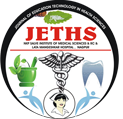- Visibility 34 Views
- Downloads 8 Downloads
- DOI 10.18231/j.jeths.2020.019
-
CrossMark
- Citation
Covid-19 pandemic: An era of opportunities and challenges in higher education
- Author Details:
-
Sunitha Solomon-Calvin *
Since its advent, Covid-19 has raced forward. It has influenced every aspect of human life and has been labelled a “pandemic” with its effects reaching epic proportions. World witnessed discernible modifications in every walks of life. Human race was forced to adapt to the changes in times of uncertainty.
According to the UNICEF, Covid has affected more than 91% students worldwide. UNESCO estimated the effect on nearly 474 Million pre-primary to upper-secondary education learners and 78 million tertiary education learners world-wide. Chaos prevailed in education and training of medical and health professionals. Institutions were forced to bring about changes in the way education was formally provided. In order to combat the situation, several recommendations were made by UNESCO and the National Governments for engaging students in online learning.
UNESCO suggested that the institutions examine the readiness of the students and choose the most relevant tools and technology solutions based on reliability of power supply, internet connectivity, and digital skills. Educational systems were to be planned that utilized approaches which limited the number of applications and platforms for synchronous and asynchronous learning. Institutions had to ensure inclusion of the distance learning programmes and implement measures to ensure that students, including those with disabilities and low-income backgrounds, have access. They were to plan the study schedules depending on the situation, level of studies, needs of students and timely monitoring of the students. Protocols were put in place to prevent violation of data privacy as well as provide a support system for all stakeholders. Priority was to be given to address possible psychosocial challenges even before teaching.
Based on the recommendations, Indian Government took up some initiatives that led to cancellation of exams, extended vacation, and introduced online education. Countrywide lock-down of schools and colleges was declared and exams were postponed. Digital India Vision was initiated as a vital tool to provide technology-based education. Ministry of Human Resource Development (MHRD) made arrangements, including online portals and educational channels and social media tools for learning.
Students suffered loss of many months of classes and practicals and their educational activity was hampered. Not all were ready for transition from face-to-face learning to online learning. The limitations to accessing the world wide web also caused disruptions in the new learning methodology. Consequently, with parents facing reduced or no salaries and unemployment, fee payment was affected, in turn effecting the institutes and faculty who are dependent on salaries. This turned out to be a vicious cycle affecting the economy and education at all levels.
Though COVID created negative impact, educational institutions have now accepted the challenges and have been trying to provide seamless education and services to students. The Medical and health professions education system got the opportunity for transformation from traditional to a new era that opened a new world of prospects. There was a shift towards blended learning with adoption of digital technologies, including simulation and online OSCE into their curriculum. With the increase in need, institutions used the situation to develop and use systems for learning and strengthening their use. Students also moved from writing to using soft copies of learning material, giving them an opportunity to manage their time more efficiently. The circumstances also gave opportunity for collaborative teaching and learning across the globe. Students had world-wide exposure and could interact with peers from around the world; adapting to an international community with an enhanced digital literacy, ease of sharing learning materials and online resolution of queries. Though there have been measures to introduce online assessment, validity and reliability remains a major concern.
It is yet to be seen if the changes would continue and gain entry into mainstream education or would just remain as an emergency response for the time-being. Although there is a strong conviction that online learning is just as effective as traditional methods, there seem to be a limited evidence specifically in health professions education. The scope of inculcating the newfound methods into mainstream programs has to prove its feasibility and acceptability by all stakeholders.
Covid is likely to have an enormous impact on the education system deep into the coming year and probably longer. Preferences in method of procuring and providing education in disciplines have undergone changes and both faculty and students are adapting to it in the best way possible, preparing for the new normal as it would be. Yet, in all, as life goes on…. So does education….
